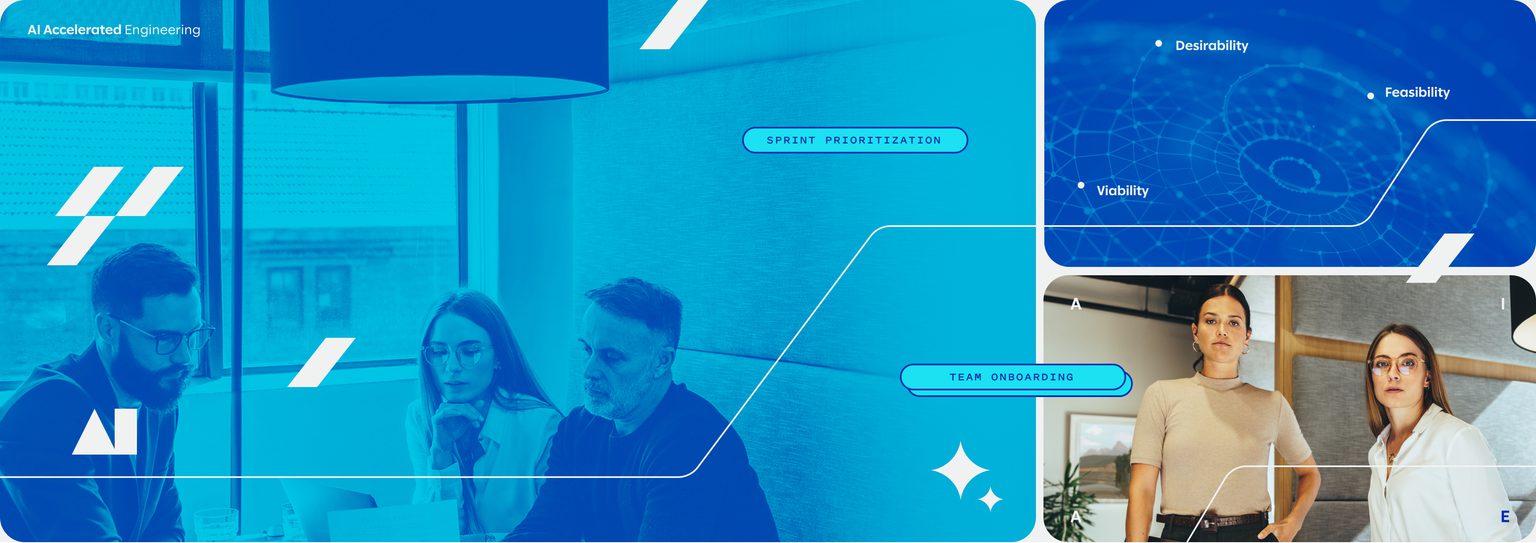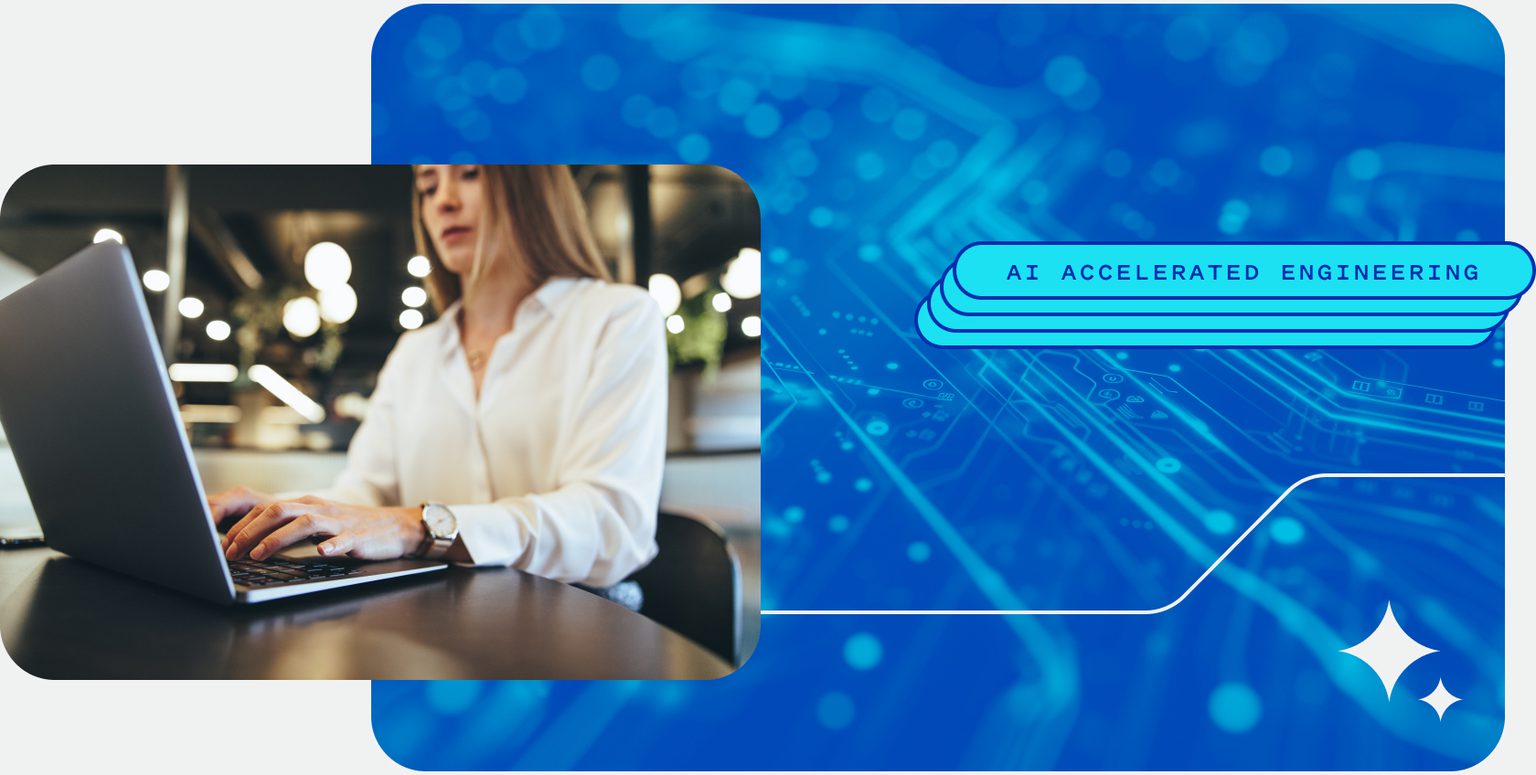
AI Accelerated Engineering
Preparing to deliver software with artificial intelligence
Benjamin Franklin’s quote, “If you fail to plan, you are planning to fail,” is correct as it relates to product development. His statement illustrates the pitfalls of rushing toward a minimum viable product (MVP) without thorough research, preparation, and planning.
To ensure our customers achieve positive results from their investment, Slalom Build engages in a design-driven discovery phase as part of our Product Engineering Methodology. Before going too far down the product development path, we seek to define an MVP with supporting design and architecture to fully understand what it will take to bring the product to market quickly.
Discovery is our foundational precursor to development that ensures your product is desirable, feasible, and viable before code delivery begins. The discovery phase allows us to address three critical elements for successful product conception: desirability, viability, and feasibility.
Key benefits of the discovery work we engage in:
- identifies key features and architecture to meet market needs
- ensures alignment of product goals with market and user needs.
- enhances product vision based on market and user research
- enables cutting-edge solutions through a technology landscape analysis
- solidifies UX and service architecture via design thinking workshops
- defines and prioritizes a Minimum Viable Product (MVP)
- reduces the risk of costly revisions by setting direction early
- shortens overall time to market by clarifying scope and requirements
Before we explore how we’re integrating AI into our discovery work, let’s examine how we’re using it to accelerate the entire software development lifecycle (SDLC), from product strategy through to support.
AI accelerated product engineering
As technology and processes have evolved, so has Slalom Build. Our team is now leveraging artificial intelligence (AI) to increase the velocity of our work, mitigate costly errors, and help our customers get the products we co-create to market faster.
Integrating AI into the software development cycle marks a transformative mind shift for our company from a traditional, serialized approach to one that is fluid and interconnected. Using AI allows each stage of product development to overlap, interact, and evolve in a more interconnected and flexible manner. This fluidity enables increased agility, adaptability, and efficiency with faster development times. We can more readily able to adapt to changes or new information as the project progresses.
AI accelerated product engineering helps Slalom Build:
- Increase project efficiency and velocity. Our customers’ products move from concept to market-ready faster, giving them a significant competitive edge.
- Reduce engineering costs. Lower development expenses mean our customers’ investments yield greater value, empowering them to allocate resources more strategically across the business.
- Centralize information. We collaborate with greater ease and make informed decisions faster, keeping projects agile and adaptable to market needs.
- Empower our partners’ teams. By sharing our AI expertise, we equip our collaborators’ teams with cutting-edge knowledge for future endeavors, amplifying their long-term innovation capacity.
- Rapid ROI determination. Understanding the potential return on the product concept earlier allows for strategic pivots and informed investment, ensuring that products not only enter the market but thrive.

Interested in learning more about AI accelerated product engineering?
How we’re using AI to accelerate the discovery phase
Incorporating artificial intelligence into the discovery phase marks a significant evolution in our approach to software development, introducing unprecedented levels of efficiency and insight. This innovation is reshaping how we tackle software engineering challenges, setting a new standard for precision and speed in transforming ideas into market-ready solutions.
Typically, the discovery phase at Slalom Build takes a team 6–8 weeks of work before developer readiness. Using AI to accelerate the discovery phase can reduce product development timelines to as little as 3 weeks, with discovery artifacts being crafted starting on day one. This sets our customers up to react to our findings sooner than before.
Artificial intelligence tools support our teams, amplifying their knowledge and skill and priming them to unlock greater value for our customers. The information gained from past experiences our experts had with clients is being used to create some of the artifacts that are essential for the discovery process.
Here’s how AI supports our experts in achieving the following discovery tasks with greater precision, efficiency, and speed.
Learning
- Gaining insight into a more enhanced product vision and objectives. AI’s ability to process and analyze vast datasets enables a more nuanced understanding of market trends, competitor strategies, and consumer behaviors based on real-world market needs and opportunities.
- Securing deeper audience insights. Machine learning (ML) algorithms uncover hidden patterns in data, offering unprecedented insights into customer preferences, behaviors, and expectations. The result is highly personalized products that enhance user satisfaction and engagement.
- Obtaining greater awareness of the technology landscape. Artificial intelligence automates the monitoring of evolving technology trends, ensuring that product development leverages the most current and effective technologies. Products remain cutting-edge, incorporating innovations that improve functionality, user experience, and operational efficiency.
- Optimizing user journeys. AI excels at predicting user behaviors and preferences to craft user journeys that are intuitive and engaging. Products are designed with a user-first mentality, leading to higher adoption rates and more positive user experiences.
Ideating
- Selecting optimal architecture and frameworks. AI tools’ analytical capabilities support the selection of the most appropriate architectures and frameworks for new projects. This ensures the product is built on a solid foundation, capable of scaling and evolving as user needs and technologies change.
- Refining service architecture. Artificial intelligence quickly and easily identifies inefficiencies and gaps in service architectures so products are designed with optimal operational flow and scalability from the outset. This foresight reduces the need for costly revisions and reengineering down the line.
- Creating UX and product design deliverables. These tools accelerate the creation of UX and product design deliverables, enabling rapid iteration and refinement. This swift process ensures designs are meticulously aligned with user needs and project goals, significantly enhancing the product's market readiness and user satisfaction to drive engagement.
- Defining and prioritizing the MVP. AI aids in identifying the most critical features for the MVP based on a comprehensive analysis of market needs, competitor offerings, and user feedback. This ensures that the MVP focuses on delivering core value to users, facilitating quicker market entry and feedback loops.
Planning
- Increasing backlog management efficiency: AI-driven tools enhance the prioritization and organization of product backlogs by evaluating the potential impact and complexity of each feature. This strategic approach ensures that development efforts are concentrated on areas that offer the most value.
- Automating user story creation. Drafting user stories is revolutionized, with AI being used to convert basic inputs into detailed narratives, significantly streamlining this foundational task. This ensures that stories evolve in tandem with changing requirements, focusing development on truly user-centric features.
- Ensuring greater accuracy for feature and timeline definition: Predictive analytics enable more accurate estimation of development timelines and effort, helping teams to set realistic goals for MVP features and overall project timelines.
- Streamlining sprint planning. AI streamlines sprint planning by generating developer-ready user stories and acceptance criteria. This ensures that each sprint is focused, efficient, and aligned with the project’s objectives.
- Assuring optimal team composition. We’re using AI to match project needs with the skills and experiences of available team members, optimizing the composition of the delivery team for maximum efficiency and effectiveness.
- Improving estimation accuracy. Leveraging historical project data, AI provides more precise estimations for tasks in the backlog, improving the reliability of sprint planning and resource allocation.
Our custom-built generative AI discovery tool
We’ve created a custom tool that uses generative AI to tie together all project requirements and artifacts and make this centralized information flow freely to be of maximum benefit to everyone. The tool ensures that if a requirement such as audience type, user story, business requirement, platform, or tech stack choice changes, it will automatically push changes into all other artifacts and deliverables.
This tool moves us from linear to “AI-parallelized” productivity.
Before
The time it would traditionally take for business requirements to manifest as working software was substantial during new build planning and intake. When changes occurred, or quality drifted, progress was halted and sent back up the chain to be manually reflected into previous steps, adding even more time and process overhead.
Now
AI parallelization uses our proprietary AI tooling and agents to automatically update requirements across all necessary capability artifacts and deliverables in near real-time as requirements evolve.
Gone are the days of manual handoffs and dependency-based workflows, returning valuable time to focus on innovation, customer experience, and business value.
Positive outcomes resulting from this tool include significantly reducing the time it takes to adapt to changing circumstances, faster and more efficient knowledge transfer, and more effective problem-solving across multiple capabilities.
Are you ready to build and innovate faster?
Quickly turning innovative ideas into ready-to-launch products is essential for staying ahead. By integrating AI into our product engineering capabilities, we’re ensuring your solution is crafted with precision and geared for success while accelerating timelines.
This means less time and financial investment to achieve a product that stands out in the market.
Are you ready to lead with a product that’s not just faster to market but is a step ahead in innovation? Join us for a free workshop to see how your vision can become a reality.